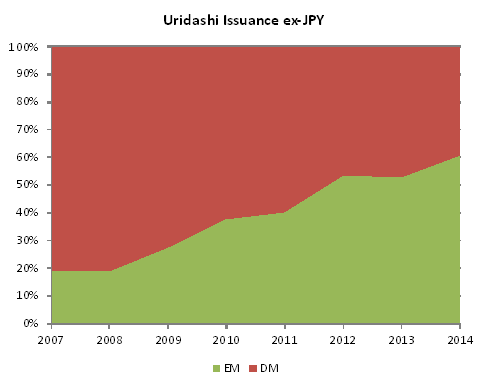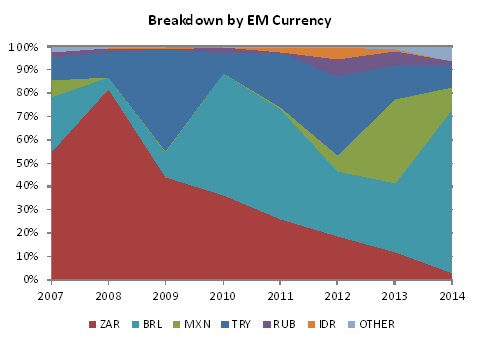The carry trade, emerging markets and Japanese retail investors
By Win Thin
Weekly MOF data show Japanese investors have sold foreign bonds for five straight weeks through January 31, and in six of the past seven. Total outflows seen in those six weeks has been -$25 bln. Given these MOF readings, we thought it would be interesting to look at recent trends in Uridashi bond issuance. As always, we net out JPY-denominated issues in order to focus on the foreign currency aspects of the Uridashi market.
Not surprisingly, Uridashi issuance remains restrained. Foreign currency-denominated issuance peaked around $25 bln in 2010 before falling three straight years to $15 bln in 2013, which was the lowest annual total since 2007. So far in 2014, we are on a $14.7 bln annualized pace of non-JPY issuance for the entire year.
Marketed to retail investors, Uridashi bonds represent a small slice of the FX market, but we believe that the observed trends in this segment can reflect those of the larger Japan investment community as well. Given near-zero rates in much of the DM and relatively high (and rising) interest rates still in EM, we think that the Japanese flows into EM should continue in the coming months. However, ongoing weakness in EM FX cannot be ignored and so strong investor demand for Uridashi bonds is not a sure thing. This would simply reflect the end of the love affair with EM that is being seen globally.

Source: Bloomberg
The share of EM-denominated Uridashi bonds has increased steadily from less than 10% in 2006 to nearly 55% in both 2012 and 2013. So far in 2014, that EM share has risen to over 60%. It is clear that the growth in EM Uridashi issuance has really come at the expense of DM stalwarts AUD and NZD. The share of these two currencies of total non-JPY Uridashi issuance was nearly 75% in 2008, but has steadily fallen to less than 30% in 2013 and to nearly 20% so far in 2014. This shouldn’t be too surprising, since AUD and NZD interest rates currently stand at historic lows after aggressive easing cycles in both countries.

Source: Bloomberg
The MXN share of total EM Uridashi issuance rose to 35% in 2013 from 7% in 2012. Its average share from 2007-2013 was 7%. Banco de Mexico’s easing cycle over the course 2013 has lessened the peso’s yield advantage, and so the MXN share has fallen to less than 10% so far this year. Fundamentals remain strong, but the peso may have trouble gaining traction if Banco de Mexico keeps rates steady this year.
The BRL share of total EM Uridashi issuance rose to 30% in 2013 from 27% in 2012. Its average share from 2007-2013 was 28%. BRL increased its share sharply so far in 2014 to over 70% of total EM issuance. With Brazil local rates still headed higher as the fight against inflation continues, BRL has regained its prior attractiveness as policymakers have worked to repair the damage to investor sentiment.
The ZAR share of total EM Uridashi issuance fell to 11.5% in 2013, down from nearly 20% in 2012 and the lowest in recent years. Its average share from 2007-2013 was nearly 40%. So far in 2014, the ZAR share is 3%. SARB has started a tightening cycle and while this should improve the rand’s yield advantage, the poor fundamental outlook could prelude much demand for ZAR-denominated issuance in 2014. Rates are still near historically low levels, and we add in ongoing social turmoil, a very weak fundamental outlook, and high risk of credit downgrades. We believe this shift away from the rand is well-deserved.
The increasing RUB share of total EM Uridashi issuance may have stalled. In 2013, the RUB share was 6% vs. 8% in 2012. Its average share from 2007-2013 was 3%. However, the ruble share has fallen to only 1% so far in 2014. The ruble should be underpinned by relatively high oil prices, but the reluctance of the central bank to tighten in response to higher inflation has likely hurt the ruble’s yield advantage.
The TRY share was 15% in 2013, down sharply from nearly 35% in 2012. Its average share from 2007-2013 was 21%. The TRY share has fallen further, to below 10% so far this year. Near-term, TRY faces strong headwinds from heightened political risk coupled with poor economic fundamentals. Relatively high rates could help support the lira until fundamentals improve, but more tightening will likely be needed to restore confidence in the lira.
Taken together, these five EM currencies make up 93% of the EM Uridashi issuance so far in 2014. From 2007-2013, these five have never accounted for less than 95% of the total EM Uridashi issuance, and are typically more in the 98-99% range. The one difference in 2014 so far is a sizable issue from Hungary, which puts the HUF share of total EM issuance near 5% this year.
Clearly, high yielders TRY and ZAR are no longer as attractive as they once were due to deteriorating fundamentals. On the other hand, Brazil has tightened aggressively and has seen demand for BRL-denominated Uridashi bonds return. The same may be said for India, which saw relatively high issuance in 2013 and 2014 after the RBI hiked aggressively. Lastly, it appears that countries reluctant to hike rates in the current environment may encounter less Japanese demand for their Uridashi bonds. Even though Mexico, Russia, and others have decent fundamentals, Uridashi issuance in their currencies has suffered.
Comments are closed.